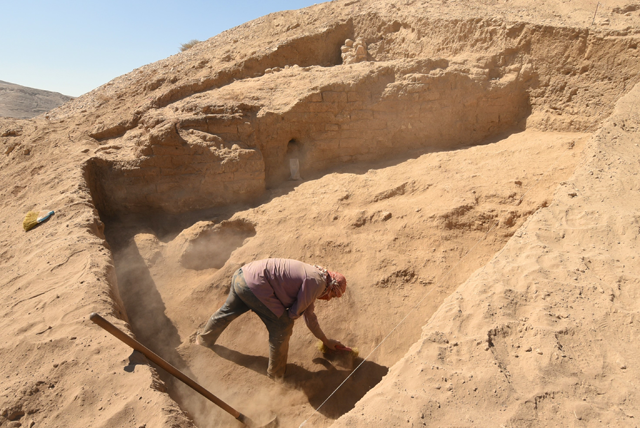AMMAN — Located in the eastern part of the southern Jordan Valley, Tell Bleibil has been researched by a team of scholars from German Archaeological Institute from Berlin.
Between 2021 and 2023, scholars focused on the Iron Age fortifications and large parts of one of the structures were excavated along the northern flank of the tell, exposing an exceptionally well-preserved Iron Age IIA/B–C (middle/late 9th–late 7th/early 6th century BC) casemate wall built of mud bricks (referred to as “Building Aˮ), of which one room (Room 3) has been excavated down to the Iron Age floor level.
"Room 3 was filled with heavily burnt and subsequently collapsed debris from the upper storey, attesting to a massive conflagration towards the end of the Iron Age, most probably dating to the early 6th century BC, based on diagnostic pottery specimens found within the debris," said archaeologist Alexander Ahrens.
This conflagration destroyed the entire building and settlement, and brought an end to this construction phase," said Ahrens.
The archaeologist added that objects retrieved from the debris of Room 3 consist of a number of complete pottery vessels, several oil lamps, a large number of loom weights, larger and smaller grinding stones, and two door sockets, clearly coming from the storey above the actual corridor.
Within this debris, also four mollusc shells were retrieved. While found within the material filling Room 3, these objects clearly were used or stored in the upper storey located above the corridor room at the time the conflagration took place.
"All four specimens are bivalve shells, three single valves of Glycymeris and a fragmentary oyster," Ahrens said.
Glycymeris is a cosmopolitan genus of marine bivalves, and specimens found in the Jordan Valley could thus come from any of the marine basins of the Middle East. Of the three shells found at Tell Bleibil, two are realistically too poorly preserved to be determined at species level, Ahrens elaborated.
The archaeologist added that the smallest specimen has been strongly abraded and polished by wave action.
"Judging from its rather sharp, steep margins, the hole near the umbo has either been artificially enlarged or is entirely artificial," Ahrens said.
"The second specimen is only a valve fragment, and equally polished and rounded at its dorsal and posterior sides; breakages along the anterior and ventral sides, however, appear rather fresh. The hole near the umbo could equally result from natural abrasion or human action," Ahrens highlighted.
The third valve is larger, and only its margins are slightly abraded. The ligament area and shell interior are well preserved. As in most species of Glycymeris, the combination of its shell outline and inflation is rather characteristic, Ahrens explained.
The archaeologist noted that the shell is moderately inflated, slightly in equilateral, and not perfectly rounded, with an obliquely truncated posterior-dorsal margin, and a rounded posterior corner.
The shell is widest at the level of this corner. This morphology is typical of the Mediterranean Glycymeris Pilosa, Ahrens underlined, noting that in the rather similar Indian Ocean species Glycymeris livida this corner is usually sharper, the posterior-ventral margin instead of the posterior-dorsal one is obliquely truncated, and the shell is generally slightly wider than high.
Valves of Glycymeris are encountered at most archaeological sites in the southern Levant, particularly those from the Iron Age, but also from earlier periods.
Single valves have often been used as pendants or in some other utilitarian fashion by intentionally making a hole at the umbo, or perhaps by enlarging a hole originally created by natural abrasion.
"This is also the case for two of the specimens found at Tell Bleibil, which are both clearly abraded and polished by wave action," Ahrens said.
"The third shell is almost entire. The differences in preservation and colour between the three specimens are due to the fact that one of the three shells – in the course of the collapse of the upper storey – was apparently deposited in heavily ash-laden debri; the other two were not, and preserve their original colour," the archaeologist noted.
"It seems reasonable to assume that all three shells came from the Mediterranean coast, given that this is ascertained for the large specimen," Ahrens underscored.
